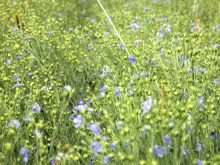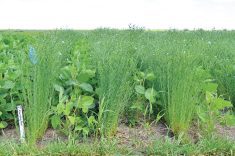The shifting sands in agricultural research were apparent last week as the Agriculture and Agri-Food Canada Morden Research Centre celebrated 100 years of innovation.
Anyone who has visited the picture-perfect grounds on the east side of town is familiar with its reputation as one of the most beautiful in AAFC’s network. Not only has it played a significant role in the evolution of Prairie agriculture, it’s served as the backdrop for many a couple’s foray into married life.
While the role of AAFC research these days, including the work carried out at Morden, is largely focused on capturing more wealth through export commodities, this station perhaps more than any other enriched Prairie life in fundamental ways that cannot be overlooked.
Read Also

Mazergroup’s Bob Mazer dies
Mazergroup’s Bob Mazer, who helped grow his family’s company into a string of farm equipment dealerships and the main dealer for New Holland machinery in Saskatchewan and Manitoba, died July 6 from cancer.
By many accounts, early settlers to the Prairies were greeted by a harsh and unforgiving landscape.
While the natural vegetation was well adapted to the region’s climate and was no doubt beautiful in its own right, it offered no sense of home to people who had left all that was familiar to carve out a new life in a new land.
Survival was the first order of business. Finding shelter and fuel and growing enough food to keep the family and livestock fed through the winter was a major challenge.
The Dominion of Canada set up a network of experimental farms to help identify which crop varieties and livestock breeds could perform well here. In March of 1915, the federal government purchased a patch of land at Morden to carry out work in general agriculture.
In its early years, the Morden research station operated the farm as a test and demonstration site, making seed of superior crop varieties and livestock available to farmers — including breeding herds of Percheron horses, Ayrshire cattle, Hampshire sheep and Barred Rock chickens.
But it soon became clear that making people feel at home required more than the bare essentials and economic opportunities. Morden became the main centre in the West for testing and developing Prairie-hardy vegetables, fruit trees and ornamental shrubs.
Between 1929 and 1936, the farm introduced 94 new varieties to Prairie horticulture, of which 77 were fruit bearing. It also released varieties of cabbage, cucumbers, sweet corn, tomatoes, eggplant, garden peas and sweet peppers.
What distinguishes these “crops” from the export crops that are the mainstay on most Prairie farms is that they are meant to be consumed and enjoyed at home or nearby. Their purpose was, and is, to make life here more palatable and esthetic.
And they made a huge difference, contributing to the quality of life in ways that defy economic measures. They made the Prairies a nice place to live.
Winkler Mayor Martin Harder summed it up well. “The beauty developed throughout this region and throughout Canada because of research at this facility is phenomenal.”
There was an economic impact too. The work of this station gave rise to a vibrant nursery and landscaping industry.
But those publicly funded ornamental and fruit programs have ended in Morden, and the genetics have been transferred to the private sector. The research there has turned to more utilitarian purposes, such as supporting the pulse, oilseed, soybean and corn industries in Manitoba.
These are important crops for helping farmers diversify their rotations and add value to their farming operations. And no doubt the decision to focus on food crops versus plants that make people’s yards look pretty, was done in the context of making the best use of limited resources.
But one can’t help but wonder how the lack of continued research into landscape horticulture will affect future generations.
Wilbert Ronald, a former ornamental breeder at the station, and one of the few dignitaries at last week’s reception who could speak to the media during a federal election, believes it will.
Companies now go to other parts of the world and select plants to try under local Prairie conditions and some of those ornamentals make superb additions.
But for trees, it’s not so easy because they can’t be covered or otherwise sheltered from winter. “Every tree that grows here is above the snow line — it gets the full brunt of the winter, the frost and they are the most unforgiving.
“There are major problems that only agriculture science can deal with such as new diseases and new pests,” Ronald said. While the private sector has stepped up, he said there is only so much it can do.
“We miss it. We wish it was here and the nursery trades wish there was some real strong Prairie research. There isn’t,” Ronald said, noting the horticultural research commitment of universities has declined too.
“It’s an ebb and flow. I hope the ebb will come back,” he said.
We couldn’t agree more.




















